Nobody Wants the Byredo x RTFKT Perfume NFTs
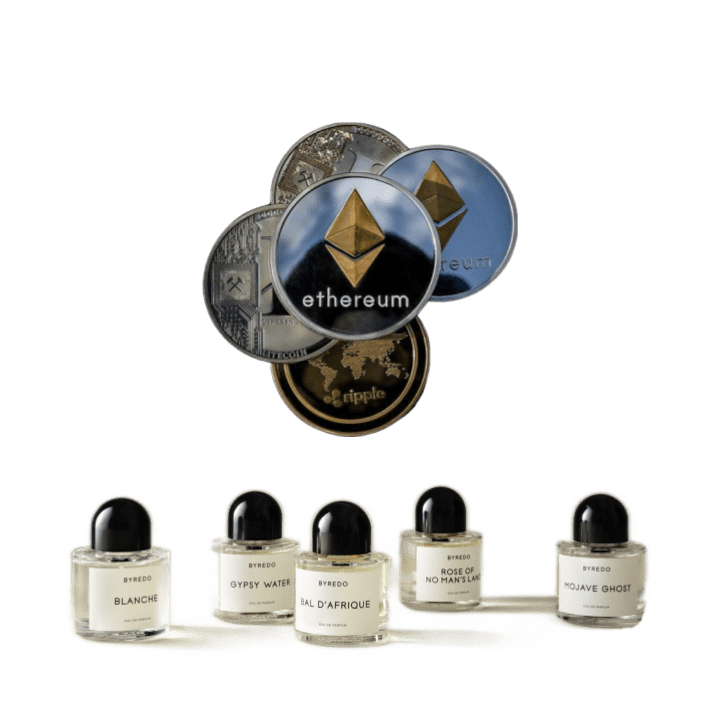
Stop trying to make “the scent of the metaverse” happen. It’s not going to happen.
Fragrance NFTs are a thing now, because of course they are. What better fodder is there for selling ownership of an intangible concept than the fundamentally tangible experience of scent?
Last week, beloved fragrance brand and Sephora headliner Byredo made headlines for releasing a digital fragrance in partnership with RTFKT, a ‘digital fashion’ company owned by Nike. You may know RTFKT from their recent schtick selling digital Nike shoes called Cryptokicks.
Owning a Byredo fragrance NFT allows a user’s digital avatar (sold separately) to wear a digital ‘aura’ that glows around them. These auras are wearable only by CloneX avatars, another RTFKT NFT project selling a collection of images of humanoid avatars with randomized combinations of physical traits. The concept of the CloneX avatar collection is similar to that of other famous NFT ‘collectible’ sets, the most famous of which is arguably the set of 10,000 Bored Ape NFTs, one of which just sold for $1.2 million three days ago.
Truly, we are living in hell.
Byredo is hardly the first brand to try the virtual fragrance thing, however.
The first was German company Look Labs, which released their Cyber Eau de Parfum collection in April 2021. Look Labs has billed itself as a ‘beauty design’ company for the purpose of the launch, but they have no other beauty or fragrance products or experience and appear to be primarily a small video game development company that also sells NFTs.
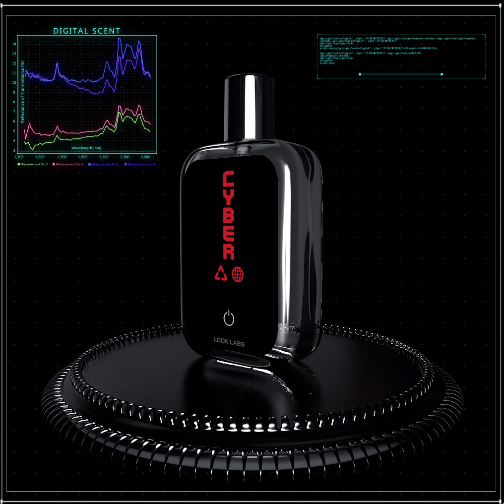
Cyber Eau de Parfum is a traditional visual NFT, where your purchase of a glorified hyperlink on the blockchain is symbolized by a picture of something — in this case, of a bottle of Cyber EdP with some graphs in the background somehow representing its scent. Purchasers were also promised a bottle of physical Cyber Eau de Parfum fragrance. The suggested price? 10 Ethereum, equaling roughly $20,960 at the time of the launch.

Supposedly, Look Labs planned to release a limited number of bottles of this real physical scent for sale in April, but I’m frankly unsure whether it ever materialized. One blog post from March 28 claims the physical fragrance drop was planned for April 11, while another published on April 8 simply said the physical fragrance drop would happen “later this month.” The tangible Cyber Eau de Parfum by Look Labs perfume is listed on Fragrantica, which bills it as a woody aromatic scent. There is not a single rating or review of it on Fragrantica or anywhere else I’ve scoured online.
One article says that Look Labs was planning to sell 888 bottles of the physical fragrance retail for $280 per 100ml bottle, but I can’t find anywhere that actually claims to have ever sold the product. This article also alleges that “The fragrance composition was left to an expert perfume [sic] from Grasse,” but no named nose has been publicly linked to the project. Supposedly, the number 888 refers to the year 1888, when the unnamed French perfumery that produced the physical product was founded. Surely a fragrance house with such esteem and history would name itself, no? It’s all feeling a little Ghost Perfumer to me — which is to say, entirely made up.
For all the fanfare and eager media attention this twist on the NFT trend got, as of this writing, Look Labs has released only thirteen Cyber Eau de Parfum NFTs, and, as of this writing, appears to have sold a whopping three of them. I’m curious whether these three people ever received a bottle of the stuff, since no one on the Internet seems to ever have smelled it.
Three purchases… or so I thought.
I clicked through each of the thirteen Cyber NFTs on Web3 platform OpenSea to find how much those three people paid for this, and now I’m not even certain three people bought these. As of this writing, OpenSea says that there are three “owners” of the NFT, but when searching the Activity tab for the NFT and filtering by all time… there are no sales. Zero. None.
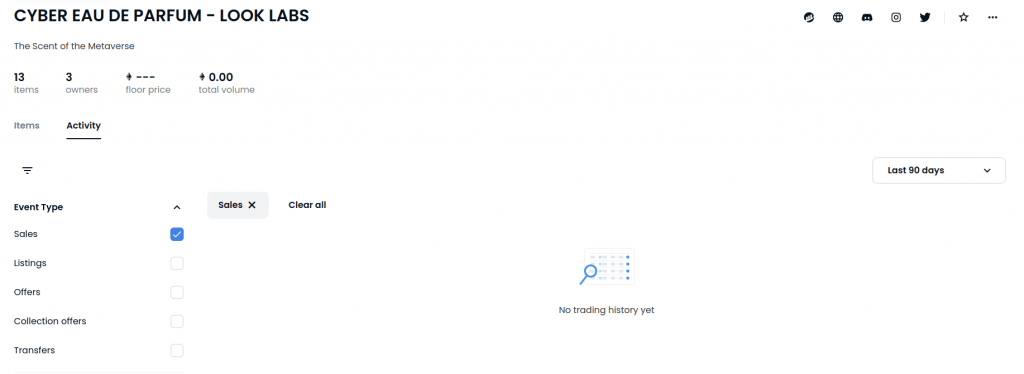
In fact, the only notable activity at all is one users’ listing of it for 8.88 Ethereum five months ago. Today, this comes out to about $9,766.93 — a generous discount! This echoes the 888 motif of the company supposedly planning to release 888 bottles of the fragrance for retail sale.
Further research made it clear to me that a rising number of NFT owners with no sales is an established bug in OpenSea. One Reddit user notes that this happens when NFTs uploaded on OpenSea are minted on blockchains like Polygon.
Dozens and dozens of flashy articles and blog posts buzzing about the world’s first virtual fragrance and not a single person bought the damn thing.
An auspicious opening to the world of fragrance NFTs.
Then in June 2021, London-Based Rook Perfumes released its Scent of the Metaverse, a collection of 100 NFTs with an interesting twist: purchasers get to join a Decentralized Autonomous Organization (DAO) to help design the actual physical fragrance. The club of one hundred purchasers gets to chat for up to 8 weeks regarding what goes into the fragrance, and then each of them gets co-creation rights.
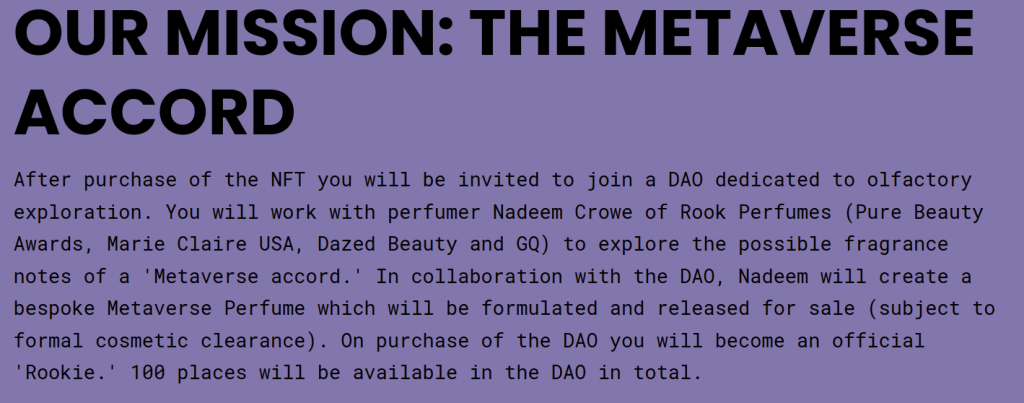
It’s a neat concept, which made me curious how it ended: It turns out that only 30 people purchased the NFT ticket to get involved. The result of their discussions, The Scent of the Metaverse: Verse 1 Extait de Parfum, is currently available for purchase for £185. Only one hundred bottles were made, so it’s currently available for a limited time. I’m kind of tempted to sample it.
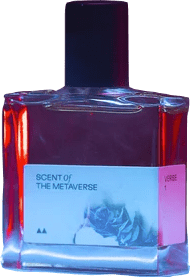
But really, do I want to sample it? DEO gimmick and affectatious cyberpunk note naming aside, this pyramid never would have caught my eye. White smoke, warm circuitry, digital rose, and celestial incense? Really? What I’m hearing is this is a warm, smokey incense and rose scent. There are no descriptive reviews, but going by the pyramid and marketing alone, it just doesn’t win me over as an incredibly interesting or unique scent.
Still, the fragrance is out there and readily available for purchase, which is more than some NFT fragrance projects can say. As an aside, it seems that Rook Perfumes agrees with me about the Look Labs Cyber Eau de Parfum having never existed in the first place, as they describe theirs as “the first NFT perfume ever created.”
Regardless of the quality of the actual scent, which I can’t fairly judge without a sample, The Scent of the Metaverse, in my opinion, is the most intriguing and valuable NFT fragrance concept so far. It jumps on trendy blockchain technology for the media coverage and intrigue, but what you’re really buying is a ticket for an experience: discussing and selecting accords for a limited-release scent. It’s a neat concept, though I don’t know whether lobbing accord ideas back and forth in a Discord server as perfumer Nadeem Crowe helplessly looks on is an experience worth the $564 to $839 each purchaser paid for their NFT. (The price was set at 0.3 Ethereum, but the value of the cryptocurrency wavered significantly during the time they were for sale.)
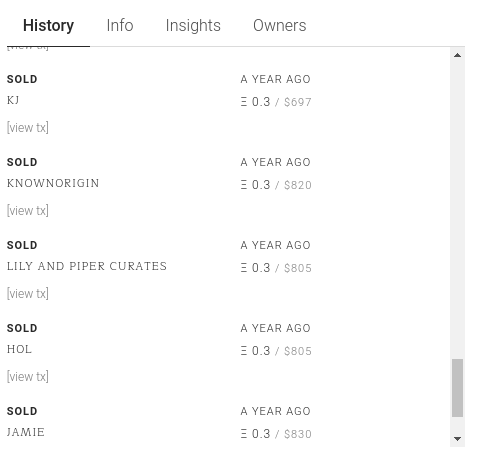
It’s a brilliant fundraising stunt, but something tells me these buyers are more likely bored rich tech people than people with an established interest in fragrance. (Maybe that’s why the note pyramid they decided on looks simultaneously so pretentiously named and so dull.) After all, for $800, you can buy a respectable set of starter ingredients and some chemistry books and spend up to eight weeks deciding on a few accords on your own. Alternatively, if you’d prefer a more expert hand, you could put those funds towards covering a hefty chunk of the tuition at the Grasse Institute of Perfumery.
Or… you could just buy perfume. Lots of perfume. Dozens of bottles, or perhaps hundreds of samples. Perhaps a lifetime’s worth of perfume. If we approximate twelve spritzes’ worth to a single milliliter, and say, for the simplicity of the calculation, that you spend that $800 on 200ml of fancy niche fragrance, and wear one spritz a day… You could wear that fancy niche perfume every single day for over six and a half years.
Or, you know. You could buy an NFT.
It is worth noting that in March 2022 beloved candy perfume house Guerlain also released an NFT project. However, their NFT collection, referred to as Cryptobees, don’t really have anything to do with fragrance conceptually. Each of 1,828 Cryptobees represents a section of the Vallée de la Millière nature reserve in France. 100% of sales of these NFTs are donated towards the rewilding of this nature reserve.
Cryptobees aside, that leaves us with three major fragrance NFT projects so far, two of which try to provide some additional value beyond (or instead of) ownership of a grainy collectible JPEG.
From these examples, it’s clear something as weird and new as a scent-based NFT will get a lot of glitzy fashion and tech media coverage, but may not sell as well as its creators have anticipated. Rook Perfumes made an astounding amount of money on the Scent of the Metaverse NFTs, but they only sold 30 of 100 of them — that’s 30%. While they did release a physical fragrance associated with the project, for all the media hype, the product isn’t exactly flying off the shelves. Some six months after the release of the physical The Scent of the Metaverse Extrait de Parfum, it has accrued a total of four reviews on the Rook Perfumes website, isn’t included in any major databases like Fragrantica or Basenotes, and still has enough of its limited batch of 100 bottles to still be selling them.
Cyber Eau de Parfum has fared even worse, selling zero NFTs. The physical fragrance allegedly created in connection with the project seems to still not exist over a year after the announcement of the project, perhaps because no one bothered to actually buy the NFTs. It is not available anywhere for retail sale and there is no perfumer name associated with the project. The group that made the NFTs is a small game design company with no perfume passion or experience.
It looks as if Cyber Eau de Parfum exists only as a theoretical list of notes, never formulated into a real fragrance at all.
Indeed, it seems that the greatest value of an NFT project might be the colossal amount of eager media coverage brands receive. Doubtless, the press around Cyber Eau de Parfum brought more recognition to small German game design studio and NFT minter Look Labs, and it launched the relatively niche Rook Perfumes into the spotlight for a few days. As just about all NFT projects do, both leaned into how limited the supply was. And yet, the majority of fragrance NFTs were left unsold.
That’s why, for all the hype, I don’t see Byredo getting much other than a flash of extra media attention out of the RTFKT NFT collaboration.
From the numbers, it’s clear fragrance people don’t care for NFTs. And why would they?
Fragrance is the very opposite of an NFT. The concepts are fundamentally antithetical to one another.
A perfume or cologne is an experience that is fundamentally tangible. You can’t convey its essence in a screenshot or a soundbite or any other method over the Internet. You have to physically be present with it to experience it. Almost no other commodity except for scents has this essential tangible quality. Perhaps food or textiles are similar, but even these have essential qualities that can be gleaned visually. A photograph of a dress or a pitaya bowl contains much more information about the essential substance and quiddity of the item than a photograph of a puddle of clear liquid we call perfume. Bottle design aside, there is very little information to be gleaned from a fragrance without physically being there and smelling it.
An NFT, on the other hand, is the very opposite: it’s intangible, a virtual certification of ownership of a specific bit of meaningless data on the blockchain. It’s a little like buying a star, or adopting a koala, in that you purchase the concept of owning something you will never actually be able to hold, see, or use for anything. Unlike a star or a koala, the thing you are purchasing ownership of is, in itself, a virtual blip with absolutely no value or purpose. That blip happens to be tied to an image or audio clip or something representing it, but the purchase gives you no rights or privileges relating to the unique thing at the face of the NFT. Buying an NFT is like virtually adopting a line of code out there somewhere, which only exists to ensure that it, itself, exists.
People who are invested in fragrance — who are interested in it beyond an “oh, that smells nice” level, who enjoy exploring it and learning about it and trying new fragrances — believe in spending their money on ephemeral, tangible experiences of pleasure.
People who buy NFTs, on the other hand, believe in spending their money on the theoretical ownership of a unique handful of ones and zeros somewhere, which will never bring them a tangible enjoyable experience.
These philosophies about the value of things and experiences run directly counter to one another.
For clarity, I’ve created a Venn diagram to further illustrate my point:

Find me one person who is excited about both fragrance and about NFTs. I’ll wait.
The thing is, it doesn’t matter. Companies are going to keep pushing imaginary virtual smells.
People who have nothing to do with fragrance, like game design studios and shoe companies, are going to keep periodically minting something they call a fragrance NFT — and most likely never issuing an actual tangible fragrance to match — because it’s an interesting concept that gets ecstatic media coverage from both the beauty and tech industries and it’s an incredibly pricey trendy product that can cost almost nothing to create.
(What’s almost worse is that they’re most likely all going to look exactly the same. Did I mention that the phrase “The Scent of the Metaverse” is the marketing linchpin for all three of these projects?)



But these are never going to sell as well as they expect. Fragrance people don’t care about NFTs. It seems like most NFT people don’t care about fragrance. These are two disparate communities with entirely different philosophies when it comes to what is and isn’t worth purchasing.
Still, when you’re selling the ownership of a theoretical concept, I suppose it only takes a few sales to turn a profit (at the expense of the environment).
So it’s going to keep happening. The fact that NFTs are made up and can be relatively inexpensive to mint means that failing to sell all of your product is no longer a big deal. The profit margins are colossal, so selling even one imaginary perfume to some tech bro with too much money can make an NFT project worthwhile.
My prediction is that however many fragrance NFTs Byredo and RTFKT mint will be too many. In fact, I don’t think they’re likely to sell even half of them. But it won’t matter, because NFTs are a cash grab.
In conclusion, Byredo, if you’re reading this: maybe Byredon’t.
Now, if you excuse me, I’m off to rearrange my perfume sample collection into one of a limited set of unique possible combinations. This one’s extremely rare. Contact me if you’d like to buy the intangible concept of it for ten Ethereum.








